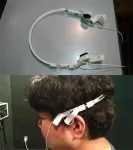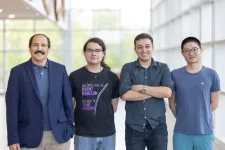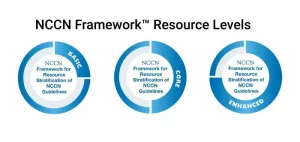Ishikawa, Japan -- Bone-conduction (BC) headphones enhance hearing capability by generating vibrations in bone or skin close to the ear, including the regio temporalis. They simultaneously leave the ear canal open to allow the surrounding air-conducted (AC) sounds for normal hearing. However, word intelligibility – recognition ability – is often poor during bone-conducted speech perceived using BC headphones due to the attenuation of its high-frequency components, especially under noisy conditions. While inserting ear plugs in the ear canal help improve the word intelligibility, it blocks the air-conducted speech.
Looking for alternative ways to address the problem of poor word intelligibility, a team of researchers led by Masashi Unoki, Professor at Japan Advanced Institute of Science and Technology, has recently proposed two methods for improving the intelligibility of BC speech with BC headphones. Their work was made available online on 29th March 2023 and published in Volume 207 of the Applied Acoustics journal in May 2023. It is co-authored by Dr. Teruki Toya, Research Fellow at Kanazawa University, Dr. Maori Kobayashi, Professor at Aichi Shukutoku University, and Dr. Kenichi Nakamura of Westunitis Co., Ltd.
Since the bone conduction and speech signal characteristics for BC transmission are different from AC sound transmission, the researchers considered the modification of BC signals due to BC transmission pathways as a major factor affecting the speech intelligibility. They identified two such transmission pathways and derived corresponding BC transfer functions – vibration of the regio temporalis (RT) and the sound radiated in the ear canal (EC), relative to AC speech sound. They then developed two methods for each of them, aiming to emphasize the higher-frequency components of BC signals.
“The two methods, first order high-frequency emphasis (FOE) and higher-order high-frequency emphasis (HOE), compensate the attenuation of high-frequency components of BC speech signals,” explains Prof. Unoki.
Based on the transfer function and the emphasis method, the researchers obtained a total of four speech signal filters – RT-FOE, EC-FOE, RT-HOE, and EC-HOE. They tested these emphasis filters via Japanese word intelligibility tests with BC headphones in noisy environments and for listeners of different ages. The results showed that BC headphones provided poor intelligibility of speech, especially for less familiar words under noisy conditions. However, the inverse transfer function between RT vibration and AC speech successfully compensated the attenuation of higher-frequency speech signals during BC transmission, improving BC speech intelligibility. “Specifically, the word recognition rate of BC speech filtered by RT-FOE was significantly higher than that with no emphasis,” Prof. Unoki points out the key result of the study.
The present study has numerous potential real-life applications, especially in BC-type hearing aids and auditory augmentation by BC headphones. “This is a basic study of BC speech perceptions. Hence, the findings of this work can help normal people as well as people with poor hearing in recovering speech recognition ability under noisy conditions. The enhanced auditory clarity in BC speech could also facilitate an interface to connect to cyberspace using BC headphones in the future,” concludes Prof. Unoki.
Bone-conduction headphones with excellent word intelligibility would certainly be a welcome step towards improving the quality-of-life of users!
###
Reference
Title of original paper:
Methods for improving word intelligibility of bone-conducted speech by using bone-conduction headphones
Authors:
Teruki Toya*, Maori Kobayashi, Kenichi Nakamura, Masashi Unoki
Journal:
Applied Acoustics
DOI:
10.1016/j.apacoust.2023.109337
About Japan Advanced Institute of Science and Technology, Japan
Founded in 1990 in Ishikawa prefecture, the Japan Advanced Institute of Science and Technology (JAIST) was the first independent national graduate school in Japan. Now, after 30 years of steady progress, JAIST has become one of Japan’s top-ranking universities. JAIST counts with multiple satellite campuses and strives to foster capable leaders with a state-of-the-art education system where diversity is key; about 40% of its alumni are international students. The university has a unique style of graduate education based on a carefully designed coursework-oriented curriculum to ensure that its students have a solid foundation on which to carry out cutting-edge research. JAIST also works closely both with local and overseas communities by promoting industry–academia collaborative research.
About Professor Masashi Unoki from Japan Advanced Institute of Science and Technology, Japan
Masashi Unoki received the M.S. and Ph.D. degrees from the Japan Advanced Institute of Science and Technology (JAIST), Nomi, Japan, in 1996 and 1999, respectively. Since 2001, he has been with the Faculty of the School of Information Science at JAIST. He is currently a Full Professor. He is a member of the Research Institute of Signal Processing, Institute of Electronics, Information and Communication Engineers of Japan, Acoustical Society of America, Acoustical Society of Japan, and International Speech Communication Association. He was the recipient of the Sato Prize from the ASJ for Outstanding Paper in 1999, 2010, and 2013 and Yamashita Taro Young Researcher Prize from Yamashita Taro Research Foundation in 2005.
Funding information
This study has been funded by JSPS KAKENHI Grants No. 17 J03679, 18H05004, and 21H03463, Japan Society for the Promotion of Science, Westunitis Co., Ltd, and Shibuya Science Culture and Sports Foundation.
END






